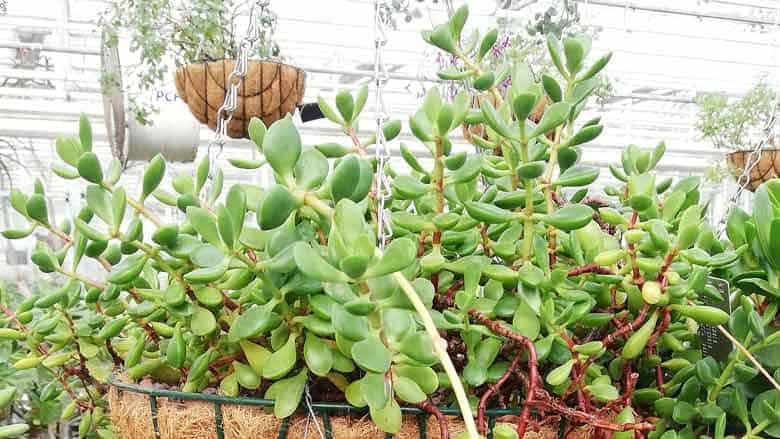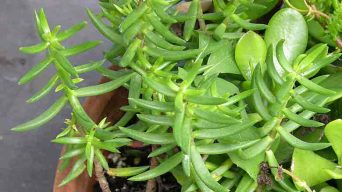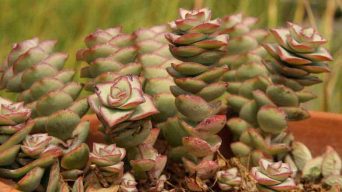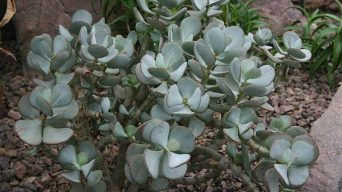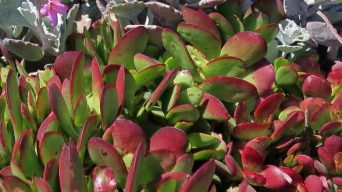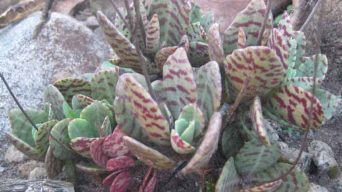The Crassula Rogersii is a succulent plant that is easy to propagate and care for.
This type of succulent has many different varieties, including the popular “Variegata.”
The Variegated variety of the Crassula rogersii plant is often used as an ornamental houseplant because of its attractive variegated leaves and ability to tolerate low light conditions.
If you are looking for a new addition to your home, or want more information on how to take care of this beautiful succulent plant, then continue reading!
About the Crassula Rogersii
| Family: | Crassulaceae |
| Genus: | Crassula |
| Botanical Name: | Crassula rogersii Schönland |
| Synonyms: | Globulea rogersii, Sedum canescens var. caulescens |
| Common Names: | Crassula rogersii |
| Origin: | Eastern Cape, South Africa |
| USDA Hardiness Zones: | 9b – 10b |
| Size: | up to 12 inches (30cm) tall |
| Sun Exposure: | Bright indirect light |
| Water Needs: | Water thoroughly but infrequently |
| Soil Type: | Well-draining soil |
| Temperature: | 72 to 82° Fahrenheit (22-28° C) |
| Humidity Levels: | 40-50% |
The Crassula Rogersii plant is a leafy succulent that originates from South Africa. It has stems with flattened, fleshy leaves and shows off colors of green or yellow-green in its summer state.
The plants are native to rocky outcroppings where they live, clinging to surfaces through small curved hooks on the ends of their roots.
The Crassula Rogersii plants are slow-growing and hardy, so that they can survive in various environments, including low light levels or dry soil conditions.
Their popularity has grown considerably due to their durability and the ease with which you can propagate them.
The Crassula Rogersii is a popular houseplant for people living in apartments or condos because it requires only average watering and little light.
The plants are also good choices for those with limited space, as they can be kept in pots that range from the size of a coffee mug to smaller than an apple.
How To Care for Crassula Rogersii
Caring for this species is easy because they’re tough little succulents that can handle a lot.
Below you will find some guidelines to help you with the general upkeep of this plant.
Sun Exposure & Light Requirements
Crassula Rogersii plants need at least four hours of sunlight each day.
They grow better in a window facing East or Southeast, providing the most light in the morning and afternoon.
Too intense sunlight can damage these succulents, so it is best not to place them in direct sunlight for long periods.
They prefer indoor locations with lots of indirect sunlight, such as windowsills or other areas where it is bright but not intense.
If you have more than one Crassula Rogersii in the same pot, ensure adequate space between each plant so they can receive enough light.
Watering
The Crassula Rogersii should be watered once a week or when the soil feels dry. Make sure the pot has drainage holes and is not blocked by gravel.
If the soil is completely dry, water it until you see a little runoff. Drain any excess water from the bottom of the pot after watering to avoid plant rot and overgrowth.
Avoid watering around leaves because this will cause leaf spots and rot on stems near the damaged area.
Water only enough until water comes out through the bottom of the pot. Avoid overflow if placing pots in saucers – put rocks under the container to catch the overflow.
Soil
Crassula rogersii does best in soil that has excellent drainage and is not too acidic. Some people recommend using cactus mix soil, a looser and more porous soil that allows for better drainage.
The soil should not be too heavy or dense and must contain plenty of organic matter in the form of peat moss, compost, manure, or leaf mold.
Using a potting mix predried before planting is best, making caring for your plants much more effortless.
Placing rocks on top of the soil will help with drainage.
If there isn’t enough space at the bottom for air pockets, place rocks or pieces of broken pots on top of your soil. This can be done using a layer of small pebbles, which some people find more aesthetically pleasing than larger stones.
The level and composition of your plants’ soil should change gradually over time. The soil in your plants should change over time. If you use manure or mulch, that will make the soil better.
Temperature
Crassula Rogersii plants are most comfortable in temperatures between 22-28 degrees Celsius or 72-82 degrees Fahrenheit.
However, they can withstand a range of 18-37°C (64-99°F) without ill effects.
They do not like cold weather and will be slow to recover from damage caused by freezing conditions, so it is best to keep the plant indoors at all times.
Humidity
The Crassula Rogersii is a succulent plant and as such it prefers dry conditions.
High humidity levels can result in root rot, so it is best to keep the environment around your crassula Rogersii on the dry side.
The leaves of crassula Rogersii are quite thick and fleshy which helps them store water for times when they cannot access enough moisture.
The optimal humidity level for crassula Rogersii is around 40-50%.
If you live in a humid area, it would be best to invest in a dehumidifier so that your crassula Rogersii can stay healthy.
Fertilizing
The Crassula Rogersii succulent plant tends to thrive in well-draining soil with a neutral pH. You should prepare the soil before planting by adding peat moss, sand, or other organic materials.
When you fertilize your plants, use an organic fertilizer like compost tea. This will give better results than a chemical fertilizer because it does not have lots of salt that can hurt the plant leaves.
This plant is susceptible to overfertilization, so you should only fertilize once a month during the growing season.
If you notice that your Crassula Rogersii succulent has yellow or brown tips on the leaves, it might be because of too much fertilizer. You can transplant the plant into peat moss before applying organic compost tea.
Potting and Repotting
Potting and repotting Crassula rogersii should be done every year or two so the roots have the space they need to grow.
Repotting is necessary because this crassula plant grows quickly; if it outgrows its container, it will start dying back.
The potting process can be done any time of year but should only happen in warm enough months for the plant to survive outdoors without protection.
The type of soil used when repotting a crassula rogersii depends on what kind of environment your succulent prefers.
If you want an optimal result, use cactus/succulent mix or Akadama clay with pumice stone added as needed. This planting mixture provides water drainage, air circulation, and insulation from
To pot the Crassula rogersii, you will first want to wash off any loose debris outside your container with clean water before planting.
Next, place some cactus soil into your container until about one inch below the top rim. Ensure the soil is well mixed, and then plant your Crassula rogersii.
If you have a tall pot, it can grow multiple stems. But if you use a shallow container or bowl planter with one stem per pot.
A good rule of thumb is to place the pot or container in a location that receives at least six hours of sunlight daily.
Keep watering your Crassula rogersii once a week, and only water it once a day.
It’s important to have good air circulation, making sure you pick the right size pot or container for your plant. It has to have good drainage holes and enough room for airflow all around the plant.
Another option is to use an open dish planter instead of a traditional closed pot, allowing excess moisture to evaporate into the atmosphere.
Pruning a Crassula Rogersii
The first thing to do when you are taking care of a crassula rogersii is pruning. Pruning the plant will help it grow faster and healthier and keep its shape tidy.
To start, cut off any brown or dried leaves that have fallen from the rest of the plant.
Next, look at where branches are coming from the stem. If they are heading away from their tips, you should cut them back so that they don’t grow in a way that makes it hard for them to branch.
You can wait until summer before cutting anything.
Carefully trim all of the extra growths off with your scissors. Be careful so that you do not damage more than intended.
Pests and Diseases
Pests
You might find two major pests on your Crassula Rogersii: mealybugs and scale. They can spread fast, so treating them as soon as they’re spotted is essential.
The good news is that both these pests are relatively easy to control, plus there are many natural ways to get rid of them with products found in the kitchen or garden.
Mealybugs
Inspect leaves and stems for white cottony masses. If found, wipe them off with a cloth dipped in alcohol or carefully use your fingers to remove the pests.
The plant will regenerate lost tissue soon enough.
You can also use organic pesticides safe for food plants, such as insecticidal soap, to kill any mealybugs on contact.
Spray it onto all plant surfaces, including leaf undersides, where mealybug infestations may occur. Repeat every few days until no signs remain of these bugs.
Scale
Gently scrape off the scale with your fingers, a cotton swab dipped in rubbing alcohol, or the edge of a dry paper towel.
If you use soap to wash them away, repeat them every few days, as they will return soon enough.
As long as mealybugs and scales are dealt with quickly and efficiently by early detection, there is no need for concern.
However, if these pests do get out of hand, then it’s time to bring out the big guns:
Neem oil: This organic product has been used for centuries in Asia. It kills parasites such as aphids while at the same time inhibiting fungal growth in plants without using harsh chemicals.
Spray this plant at the first signs of leaves drooping or wilting.
Diseases
The most common diseases that affect the Crassula rogersii succulent plant are root rot and fungi.
Root Rot
As a result of being overwatered, Crassulas can develop root rot or stem rot, which will lead to leaf drop.
The leaves may have brown tips with small black spots resembling salt deposits. This is evidence of rotting roots caused by too much water in the soil.
If left untreated, the decay within the plants might spread and kill it.
To prevent these problems from occurring, make sure to avoid watering your Crassula when they are in bloom or during hot days when evaporation rates increase.
When watering, use cold water because it’s better at conserving moisture than warm water.
Fungi
The fungus can be a problem for the Crassula rogersii plant. It will usually appear as black spots on the succulent leaves or ground around it.
The fungus is common in areas that experience wet, cold winters with hot, dry summers. These conditions create perfect weather for fungi to grow.
When an infection occurs, use organic remedies such as neem oil so you don’t have to resort to harsh chemicals which could harm your crassula plants.
How To Propagate Crassula Rogersii Plants
A Crassula Rogersii can be propagated by taking cuttings or pups.
These are usually removed from around the mother plant’s base before being repotted in good potting soil and watered well until established.
If there isn’t enough light where they’ll grow, place them somewhere with more sunlight – but never direct sun!
The best time to do this is either at the end of summer when growth slows down or during winter (but not too early). This will give them plenty of time to grow and establish themselves before the next growth period begins.
The cuttings will need good light, water, air circulation, and room temperature for the best results in the propagation process.
Is the Crassula Rogersii Toxic?
The Crassula Rogersii plant is not toxic. If ingested, it may cause some gastrointestinal irritation in humans and animals. Still, the plant has no known toxicity effects on human or animal health.
Final Thoughts
The Crassula Rogersii is an excellent plant for many reasons.
They are easy to care for, durable plants with beautiful blooms that can thrive in the most low-maintenance environments.
If you want an attractive succulent but only have a little time on your hands, this may be just what you’re looking for!

